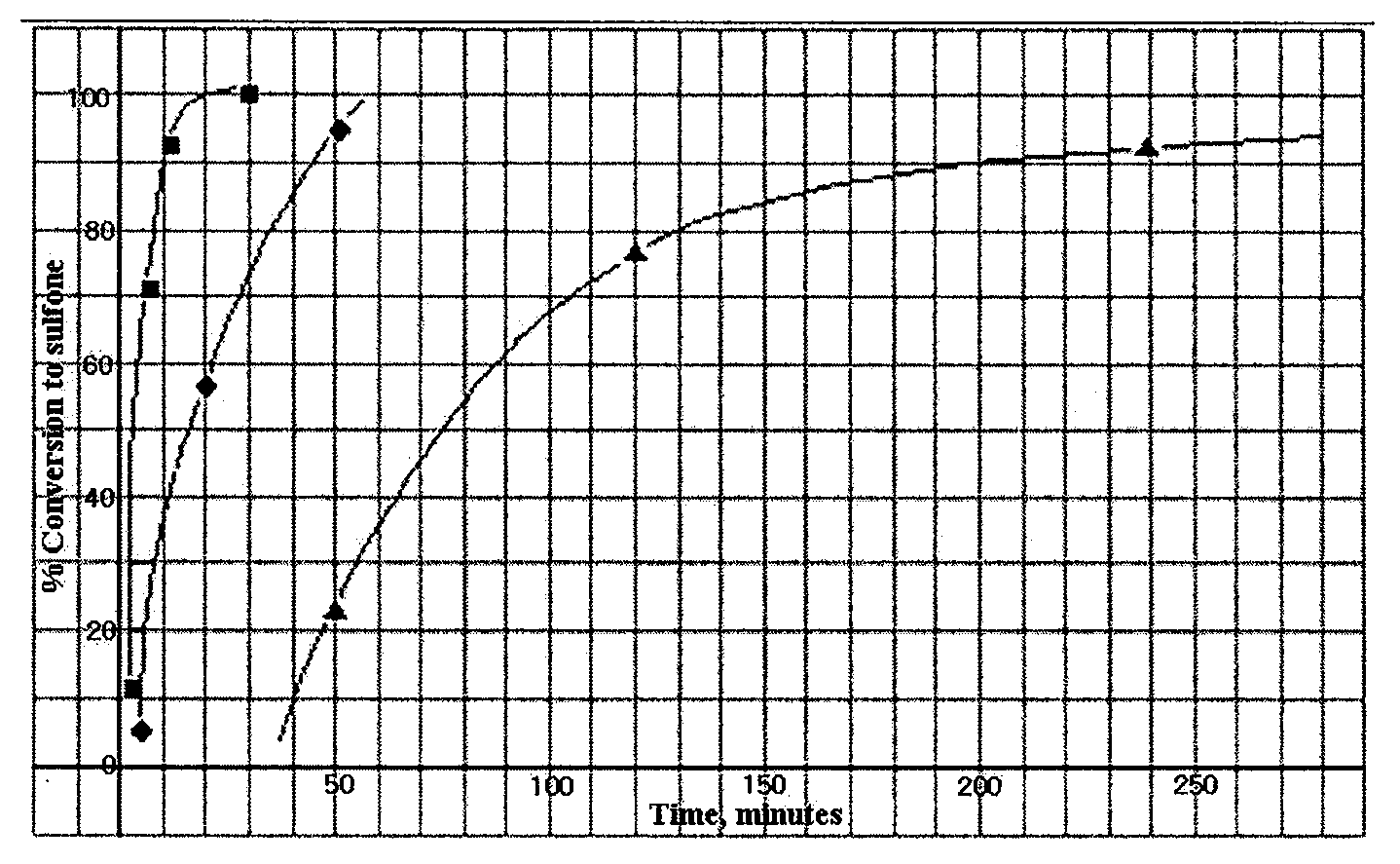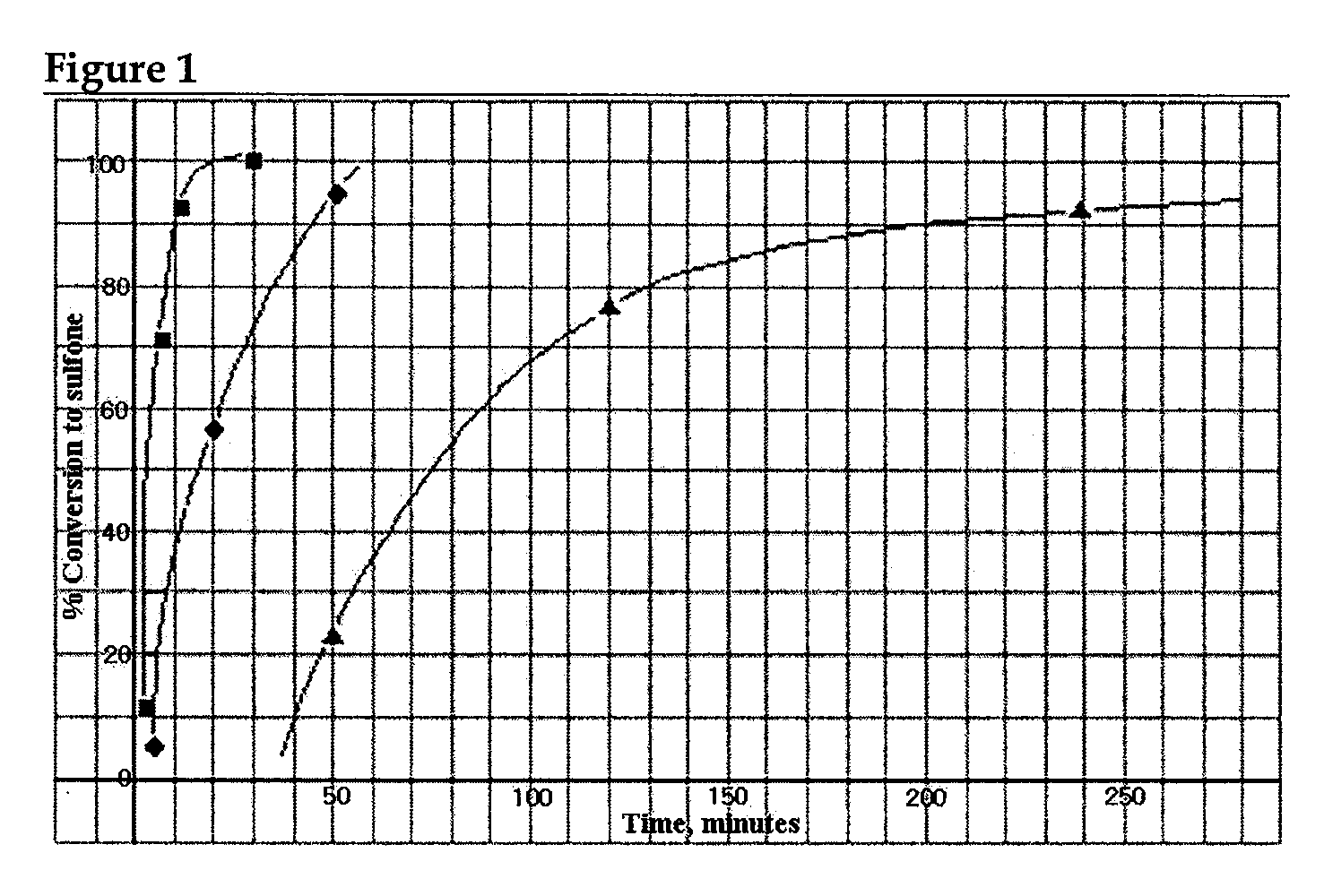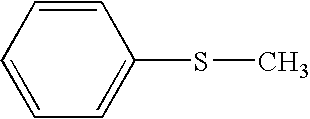One-pot process for the reduction of sulfur, nitrogen and the production of useful oxygenates from hydrocarbon materials via one-pot selective oxidation
a selective oxidation and hydrocarbon material technology, applied in the field of one-pot process, can solve the problems of increasing difficulty in removing hydrocarbon fractions in petroleum, difficult to meet the near zero sulfur target, and difficult to remove by conventional refinery processes
- Summary
- Abstract
- Description
- Claims
- Application Information
AI Technical Summary
Benefits of technology
Problems solved by technology
Method used
Image
Examples
example 1
(1) Preparation of “Mono-Phasic” Selective Oxidation System of “Mono-Metal Homogeneous Catalyst”+“TBHP Oxidant”
[0070]A homogeneous catalyst solution was prepared as follows. S-, N-compounds and benzylic hydrocarbons such as tetralin contained in hydrotreated LCN, HCN, LCO, HCO and clarified oil may be selectively oxidized in a reactor by using the homogeneous catalyst solution.
[0071]A homogeneous catalyst was prepared by using M-complex salts dissolved in hydrocarbons such as M-naphthenate, M-stearate, M(CO)6, MO2(acac)2 (acac: acetylacetonate), M-octoate (M: Mo, V, Te, Re, Ta, Nb) or by reacting non-soluble precursors such as various metal powders (e.g. Mo, V, Te, Re, Ta and Nb), MoO3 and molybdic acid with TBHP contained in t-butyl alcohol (TBA).
[0072]In particular, Mo(oxirane) homogeneous catalyst has a relatively high selectively oxidative activity, and 1,000 mL of blue catalyst solution was prepared by dissolving 1.48 g of Mo powders (<200 mesh size) in a mixed solvent of TBHP:...
example 2
(1) Preparation of “Mono-Phasic” Selective Oxidation System of “Binary Homogeneous Catalyst”+“TBHP Oxidant”
[0078]Various selective oxidation systems of “binary homogeneous catalyst”+“TBHP oxidant” was prepared by incorporating a secondary metal compound, in particular a metal and / or an organometal compound that may promotes the selective oxidation of allylic and benzylic hydrocarbon as shown in Table 4, into the blue Mo(oxirane) catalyst prepared by dissolving Mo powders in TBA / TBHP
(2) Selectively Oxidative Activity of “Mono-Phasic” Selective Oxidation System of “Binary Homogeneous Catalyst”+“TBHP Oxidant”
[0079]Selective oxidation of DBT was conducted by using thus prepared selective oxidation system of “binary homogeneous catalyst”+“TBHP oxidant” at 80° C. and under atmospheric pressure for 2 hours, and the results are presented in Table 5.
TABLE 5No.Catalyst% TBHPDBT sulfone1.Mo(oxirane)-Co(acac)23.65(−)*[TBA / TBHP] [benzene]2.Mo(oxirane)-Mn(acac)34.06(−)*[TBA / TBHP] [benzene]3.Mo(ox...
example 3
[0085]Each of refractory thiophenes such as DBT, 4-MDBT and 4,6-DMDBT was dissolved in Mo(oxirane) catalyst solution and oxidized with TBHP. The time dependency of degree of oxidation was observed, and the results are presented in FIG. 1 (: 4,6-DMDBT, o: DBT, Δ: BT).
[0086]FIG. 1 shows that the reactivity trend of the refractory sulfur compounds toward the selective sulfoxidation process become exactly opposite to that observed in the conventional HDS reaction. The most refractory sulfur compound, 4,6-DMDBT, which is stable at an elevated temperature (650° C.) and resistant to desulfurization even under the extreme conditions of the HDS process, becomes the easiest substrates for the selective oxidative.
[0087]These results explicitly show that S-free or deep or ultra-deep desulfurization may be achieved according to the present invention such as TGO, thereby overcoming the technical problems in the conventional HDS process.
PUM
| Property | Measurement | Unit |
|---|---|---|
| vol % | aaaaa | aaaaa |
| vol % | aaaaa | aaaaa |
| vol % | aaaaa | aaaaa |
Abstract
Description
Claims
Application Information
 Login to View More
Login to View More - R&D
- Intellectual Property
- Life Sciences
- Materials
- Tech Scout
- Unparalleled Data Quality
- Higher Quality Content
- 60% Fewer Hallucinations
Browse by: Latest US Patents, China's latest patents, Technical Efficacy Thesaurus, Application Domain, Technology Topic, Popular Technical Reports.
© 2025 PatSnap. All rights reserved.Legal|Privacy policy|Modern Slavery Act Transparency Statement|Sitemap|About US| Contact US: help@patsnap.com



